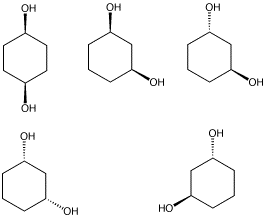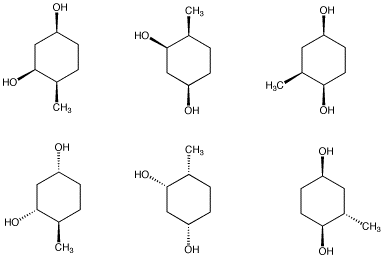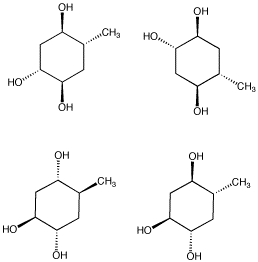SC20. Stereochemistry - Extra problems.
Optical rotation
Problem SC20.1.
The (+) enantiomer of compound
A has an optical rotation of 125o.
If a pure sample of compound A has an optical rotation of 100o, what
is the composition of the sample?
Problem SC20.2.
The (+) enantiomer of compound
B has an optical rotation of 100o.
If a pure sample of compound B has an optical rotation of 95o, what
is the composition of the sample?
Problem SC20.3.
The (+) enantiomer of
compound C has an optical rotation of 18o. If a pure sample of
C contains 30% of the (+) enantiomer and 60% of the (-) enantiomer, what is the
optical rotation value?
Problem SC20.4.
The (+) enantiomer of
compound D has an optical rotation of 25o. If a pure sample of
D contains 80% of the (+) enantiomer and 20% of the (-) enantiomer, what is the
optical rotation value?
The polarimetry experiment
Problem SC20.5.
A pure sample of the
naturally-occurring, chiral compound A (0.050 g) is dissolved in water (2.0 mL)
and the solution is placed in a 0.5 dm cell. Three polarimetry readings
are recorded with the sample: 0.625o, 0.706o, 0.682o.
What is [a]?
Problem SC20.6.
A pure sample of the
chiral compound B (0.540 g) is dissolved in ether (2.0 mL) and the solution is
placed in a 1.0 dm cell. Three polarimetry readings are recorded with the
sample: 1.225o, 1.106o, 1.182o.
What is [a]?
Problem SC7.7.
A pure sample of the (+) enantiomer of compound C shows [a]
= 42o. What would be the
observed a if
a solution of the sample was made by dissolving 0.250 g in 2.0 mL of
acetontirile and was then placed in a 0.5 dm cell?
Problem SC20.8.
A student has prepared
compound D in lab. She is sure the compound contains no impurities; a
number of physical analyses have confirmed the structure and purity of the
compound. A sample of compound D (0.10 g) is dissolved in methanol (2.0 mL)
and the solution is placed in a 1.0 dm cell. Three polarimetry readings
are recorded with the sample: 0.995o, 0.904o, 0.936o.
a) What is [a]?
b)
The optical rotation of D has previously been reported as 25o.
What is the optical purity of this sample?
c) What is the
enantiomeric excess of this sample?
d) What is the
composition of this sample?
e) Why did the previous
analyses show that there was only one compound present?
Problem SC20.9.
Suppose a student prepared a sample of a compound with known
[a] = 40. The
student did not realize that her sample contained 10% (by mass) of a non-chiral
impurity. After correcting for c and l, what did she measure for
[a]?



